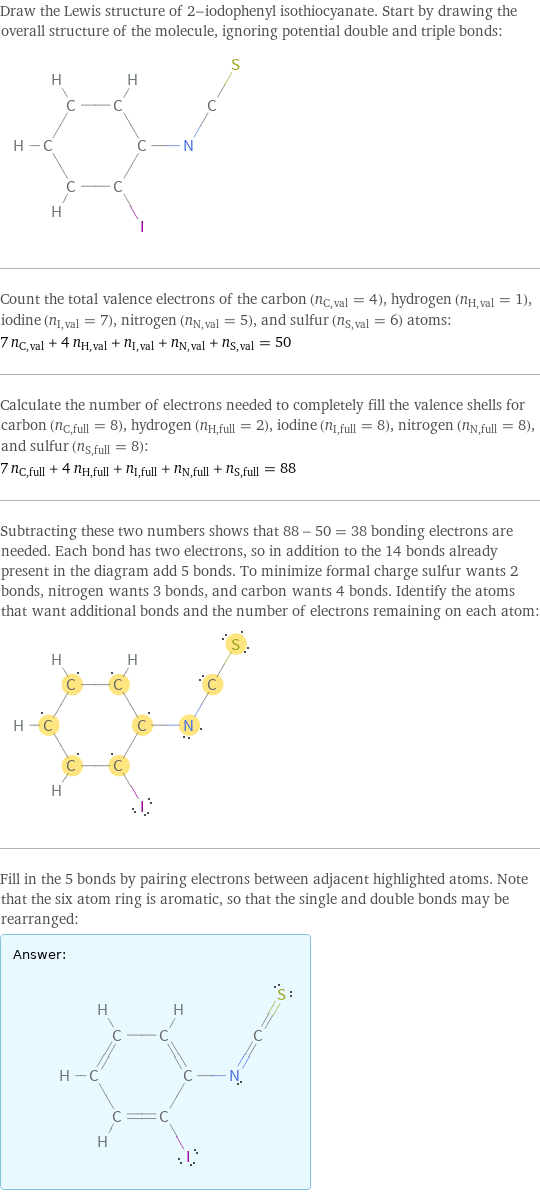Input interpretation

2-iodophenyl isothiocyanate
Chemical names and formulas

formula | IC_6H_4NCS Hill formula | C_7H_4INS name | 2-iodophenyl isothiocyanate IUPAC name | 1-iodo-2-isothiocyanatobenzene alternate names | 1-iodo-2-isothiocyanato-benzene | 1-iodo-2-isothiocyanatobenzene | 2-iodoisothiocyanatobenzene mass fractions | C (carbon) 32.2% | H (hydrogen) 1.54% | I (iodine) 48.6% | N (nitrogen) 5.37% | S (sulfur) 12.3%
Lewis structure

Draw the Lewis structure of 2-iodophenyl isothiocyanate. Start by drawing the overall structure of the molecule, ignoring potential double and triple bonds: Count the total valence electrons of the carbon (n_C, val = 4), hydrogen (n_H, val = 1), iodine (n_I, val = 7), nitrogen (n_N, val = 5), and sulfur (n_S, val = 6) atoms: 7 n_C, val + 4 n_H, val + n_I, val + n_N, val + n_S, val = 50 Calculate the number of electrons needed to completely fill the valence shells for carbon (n_C, full = 8), hydrogen (n_H, full = 2), iodine (n_I, full = 8), nitrogen (n_N, full = 8), and sulfur (n_S, full = 8): 7 n_C, full + 4 n_H, full + n_I, full + n_N, full + n_S, full = 88 Subtracting these two numbers shows that 88 - 50 = 38 bonding electrons are needed. Each bond has two electrons, so in addition to the 14 bonds already present in the diagram add 5 bonds. To minimize formal charge sulfur wants 2 bonds, nitrogen wants 3 bonds, and carbon wants 4 bonds. Identify the atoms that want additional bonds and the number of electrons remaining on each atom: Fill in the 5 bonds by pairing electrons between adjacent highlighted atoms. Note that the six atom ring is aromatic, so that the single and double bonds may be rearranged: Answer: | |
3D structure

3D structure
Basic properties

molar mass | 261.08 g/mol phase | solid (at STP) melting point | 37 °C boiling point | 296 °C
Units

Chemical identifiers

CAS number | 98041-44-2 PubChem CID number | 145310 PubChem SID number | 24871185 SMILES identifier | C1=CC=C(C(=C1)N=C=S)I InChI identifier | InChI=1/C7H4INS/c8-6-3-1-2-4-7(6)9-5-10/h1-4H MDL number | MFCD00041057
Safety properties

flash point | 110 °C

DOT numbers | 2811